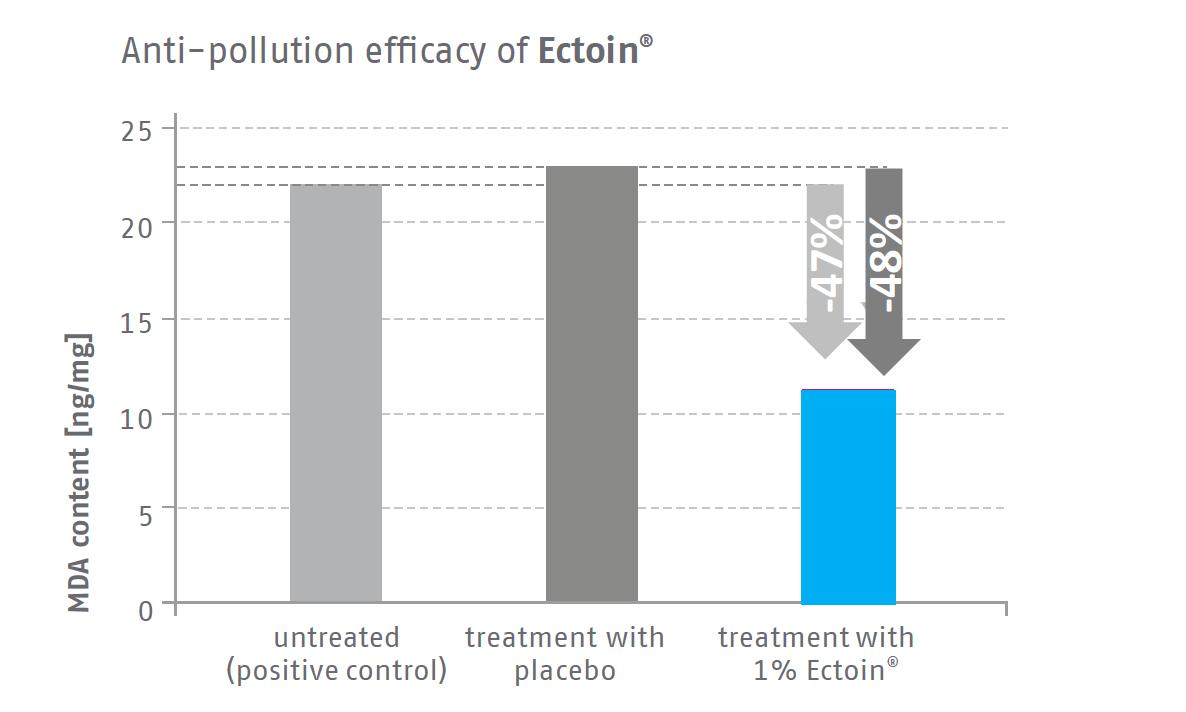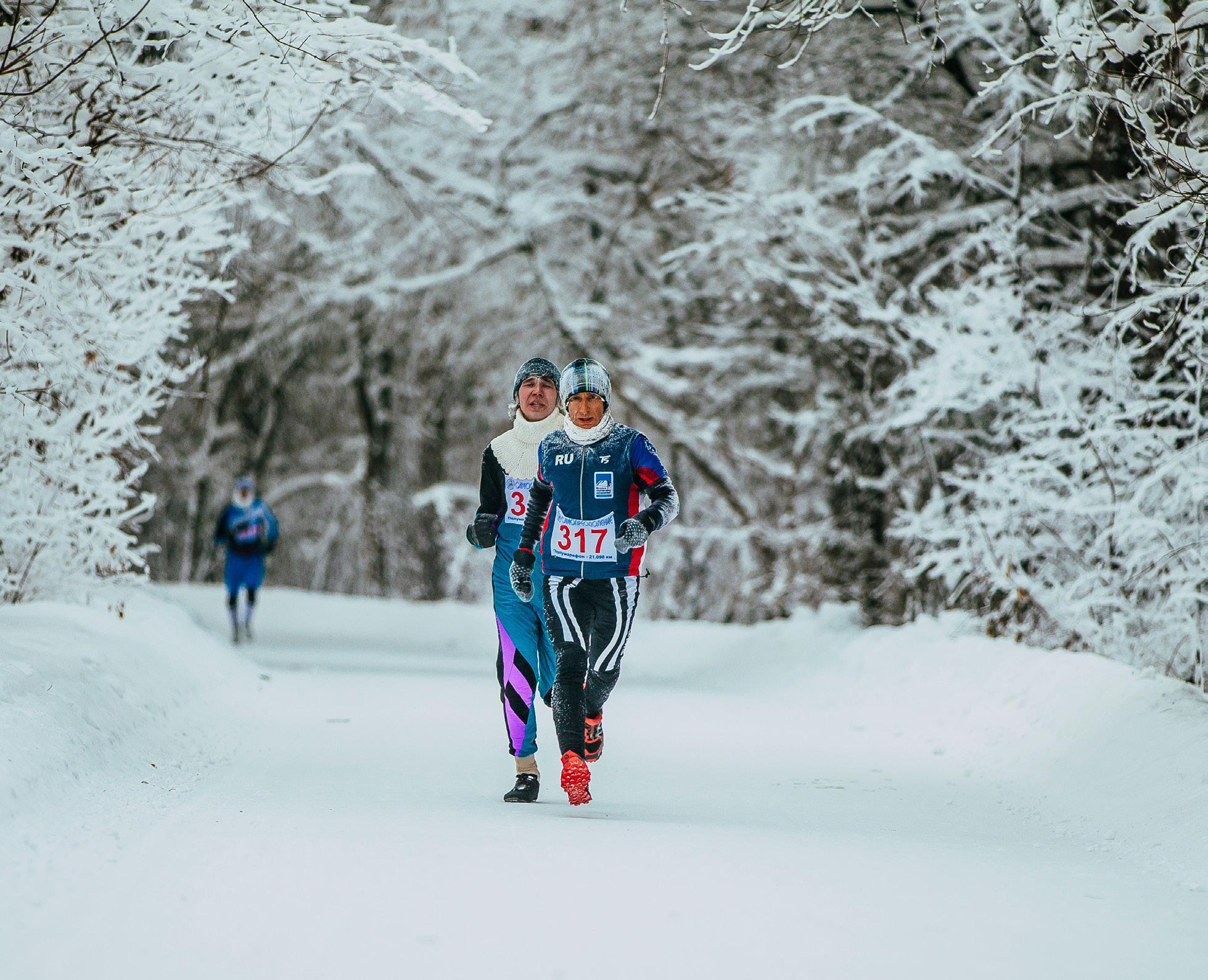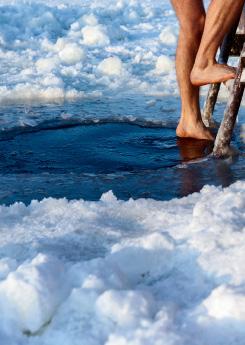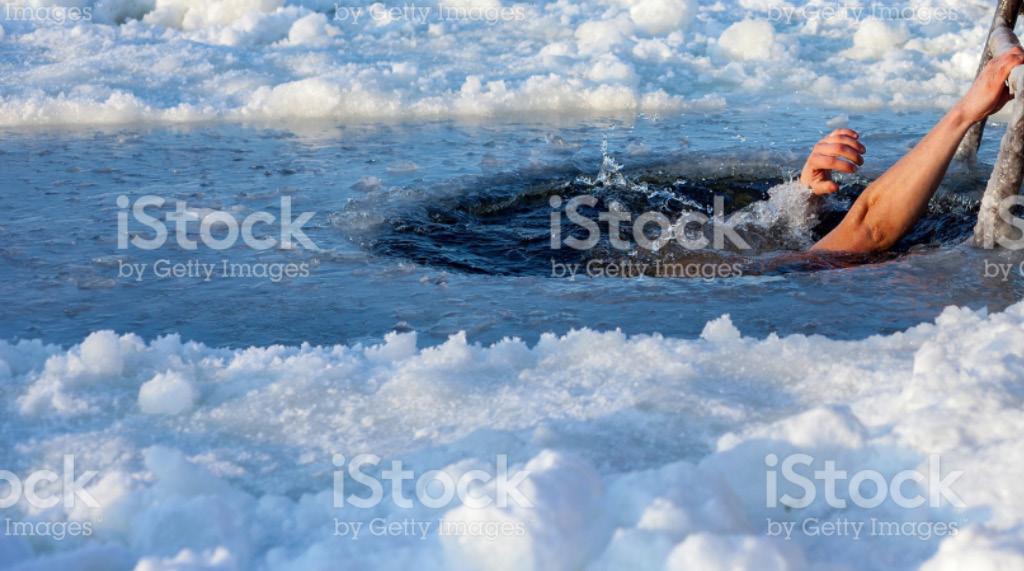
16 minute read
ECTOIN, A DERMATOLOGICAL SOLUTION
from I Care Issue
by NAQI Belgium
RANDOMIZED STUDY DATA CONFIRM ANTIPOLLUTION ACTIVITY WITH ECTOIN®
BASED ON THE ARTICLE BY SILKE SCHAGEN, SABRINA OVERHAGEN, SUSANNE GRETHER-BECK, JEAN KRUTMANN, ANDREAS BILSTEIN 1 - BITOP 2
ABSTRACT
It is known that air pollution may contribute to accelerated skin aging. The attention of skin care research related to the negative influences of air pollution on the skin is usually focused on particulate matter (PM10, PM2.5, PM1, PM.1, and smaller), which can be released from different sources, either occurring naturally or being human-made. Because of their size, these particles remain adhere to the skin very welland can be contaminated with toxic substances, such as polycyclic aromatic hydrocarbons (PAH). These PAHs, mainly produced by biomass burning, can cause oxidative stress to the skin and damage connective tissue and cellular proteins. Ectoin® is known to strengthen the skin's barrier function, to work against variable stressors, such as UVA/UVB radiation, IR-A, high-energy visible light, or allergens, and for its anti-inflammatory properties. This study demonstrates the protection and prevention capabilities of Ectoin® from air pollution (PAHs, PM2.5, PM1, PM and smaller).
INTRODUCTION
The WHO defines air pollution for two areas, indoor and outdoor. The contamination of the air is caused by chemical, physical, or biological agents that modify the natural characteristics of the atmosphere. Pollutants of major public health concern include particulate matter and gases such as carbon monoxide, ozone, nitrogen dioxide and sulphur dioxide1 . Air pollution in the European metropolitan areas has decreased in recent years due to strict control measures, but is still high enough to exceed the limits in various cities many times a year. For a number of Asian (Karachi, New Delhi, Kathmandu, Bejing), Latin American (Lima, Arequipa), and African cities (Cairo), air pollution data is reported as very high, causing many related health issues. Even in the relatively cleaner cities of Europe or North America, where particulate matter (PM) levels are 3–5 times lower, substantial health effects can be observed2 .
Dust, soot and chemical substances, photochemically derived ozone, cigarette smoke, etc. consist of small particles. Particles can have different sizes; common classifications are PM10, PM2.5 , ultrafine particles (UP/UFP), and nanosize particles (UP or PM0.1). PM contains heavy metals, which can catalyze harmless substances into noxious agents. Ultrafine particles are carriers of ROS (reactive oxygen species) generating organic compounds. PM10 can penetrate into in human nasal cavity, PM2.5 in bronchi and pulmonary alveoli, ultrafine particles into the lung tissue and even into the bloodstream. Depending on the size and depth of penetration of the particles, the effects on health are different. Skin exposure to benzo[a]pyrene (BaP), a group
1 Euro Cosmetics, 2016, 7-8 p.22-25
of compounds known as the polycyclic aromatic hydrocarbons (PAHs), can induce inflammatory diseases and skin cancer, which are both associated to oxidative stress. BaP and PM are known to bind with specificity to the aryl hydrocarbon receptor (AhR), modifying the expression of Cyp1A1 (Cytochrome P450, family 1, subfamily A, polypeptide-1) and the release of POMC (Pro-opiomelanocortin), MMP1 (Matrixmetallopeptidase-1) and IL-6 (Interleukin-6), resulting in inflammation, formation of dark spots, collagen breakdown, and wrinkles, which may induce accelerated skin aging3, 4 . Carbon black particle exposure of lung epithelial cells seems to trigger a pathway at cell membrane level which increased expression of pro-inflammatory genes including ICAM-1 (Intercellular Adhesion Molecule-1), and is considered to play a critical role in the attachment and migration of immune and inflammatory cells to the airway mucosa5 . In addition to the upper and lower respiratory tracks6, the skin is especially exposed to air pollution, mainly to particulate matter, which has been shown to contribute to accelerated skin aging showing symptoms such as wrinkling, pigmentation, loss of elasticity, irritation and dryness, inflammation and allergic reactions, or even skin cancer or telangiectasia7, 8 .
2BITOP is a German manufacturer, around the world recognized as an expert for the biotechnological production and development of high quality extremolytes, like Ectoin® and Glycoin® natural. Extremolytes are natural stress protection molecules found inside of microorganisms and plants, which thrive in extreme habitats. They repair and revitalize biological structures and thereof, and functions and protect them from damage and degeneration. These characteristics are directly transferable to skin care products with spectacular effects.
For more information: www.bitop.de
Ectoin® is a safe and natural cosmetic active ingredient with cell protection properties. Ectoin® regulates the osmotic stress in extremophilic bacteria , and protects and stabilizes proteins, enzymes, nucleic acids, and cell membranes, when applied to human tissues. The skin barrier is stabilized and skin hydration restored. The increased degree of skin hydration is preserved for 7 days without further treatment9, 10 . Various in vitro, in vivo studies and clinical trials confirm Ectoin® activity, with regard to protection of langerhans cells11, protection from heat/IR-A, UVA/UVB12, 13 and visible light14 , inflammation reduction15, and treatment of atopic dermatitis16. In different models, Ectoin® showed a reduction of PM-induced neutrophilic inflammation and effects on PM-induced exacerbation of allergen sensitization5, 17, 18, 19 . This study will present Ectoin® data which show keratinocyte and skin protection against the damaging stress of air pollution. Ectoin® combines various types of well-established pollutionprotection effects. Ectoin® is the only pollution protection agent that also reduces allergic reactions and skin aging induced by airborne allergens such as pollen.
METHODS AND RESULTS IN VITRO STUDY
Results of this study demonstrate that Ectoin protects the skin from pollution induced damage and aging. As already described POMC, MMP1 and Cyp1A1 expression can be activated by pollution particles4 . For this in vitro study fresh human epidermal keratinocytes from female Asian and female Caucasian donors were used. Cells were untreated and pre-treated (24h) with 2mM Ectoin solution. After treatment, cells were stressed with fine and ultrafine carbon black particles and different types of exhaust particles (Tab. 1). Then, POMC, MMP1 and Cyp1A1 mRNA expression were measured in keratinocytes by using real time PCR. This results in figure 1 show that fine and ultrafine carbon black particles and diesel particulate matter induced POMC, MMP1 and Cyp1A1 mRNA. POMC is known for melanogenesis stimulation in human melanocytes and to cause dark spot formations. MMPs play a role in collagenase and elastase breakdown in the extracellular matrix of the dermis. Cyp1A1 mRNA expression induces oxidative stress in human skin which results in inflammation or cancer. Ectoin protected keratinocytes significantly down regulated PM induced overexpression of marker genes. POMC mRNA expression is down regulated in all tested cases by 100% or close to 100%. In addition, Ectoin also protected from upregulation of MMP1 and Cyp1A1.
Tab.1: Different types and sizes of particulate matter were used:
Particulate Matter Type
Both particles are much smaller than PM2.5 and PM1 ultrafine particles
fine particles
Name Size
Printex 90 0.014μm particle diameter Huber 990 0.26μm particle diameter
Both materials contain PAHs and heavy metals as well as PM10 , PM2.5 and PM1 diesel engine exhaust soot from heavy duty equipment engines SRM 1650 –
diesel soot from a forklift engine SRM 2975 –
A )
B )
C )
Figure 1: Up-regulation of A) POMC, B) MMP1 and C) Cyp1A1 mRNA expression in primary human keratinocytes (Asian and Caucasian) by sub toxic amounts of ultrafine and fine carbon black particles and by two different types of exhaust particulates. 18S ribosomal RNA (rRNA) was used as a housekeeping gene to normalize mRNA expression. A) Ectoin treatment downregulates PM induced POMC overexpression. The remaining response is calculated by setting the pollution induced effect equal 100%. B, C) Ectoin reduces MMP1 and Cyp1A1 up-regulation and protects keratinocytes also from fine carbon black particle and diesel particulate matter
IN VIVO STUDY
To test in vivo the anti-pollution activity and efficacy of a cream containing Ection®, a specialized dermatological center in Germany was chosen. The study design (placebo controlled, randomized, double blind) is the most innovative, standardized in vivo pollution test method currently available. Six volunteers applied the cream with placebo or 1% Ection® on volar forearm for 5 days twice daily. Furthermore, areas on the volar forearm were tested untreated and unstressed (negative control) as well as untreated and stressed with cigarette smoke (positive control). On day 5, skin was stressed with cigarette smoke as pollutant for 15 minutes to induce oxidative stress to the skin in a standardized pollution chamber system.
The protective activity of the test products was evaluated by analysis of barrier lipid oxidization levels (measured by malondialdehyde, MDA) of ex vivo samples from the skin surface. MDA results from lipid peroxidation of polyunsaturated fatty acids and is one of the reactive electrophile species that cause toxic stress in skin cells and can therefore be used as a marker for air pollution induced damage.
5 Days of Ection® containing cream application showed a positive effect. The pollution induced MDA overexpression was 48% lower compared to placebo and 47% lower compared to untreated but challenged control. A clear trend towards efficacy in protection against pollution induced skin damage was observable. Ection® is a full spectrum pollution protection active ingredient. After only 5 days of application, the pollution induced lipid peroxidation in the skin was remarkably reduced by 48%. Ection®is capable to shield the skin from the whole spectrum of air pollution components including metals and PAHs as well as all particle siwes (PM2.5, PM1, PM 0.1 and smaller) - for a complete and instant protection and prevention of pollution induced damage and skin aging.
SUMMARY AND DISCUSSION
Ection® strengthens the skin barrier function and is capable to shield the skin from the whole spectrum of air pollution and allergens. This includes clouding metals and PAHs as well as all particle sizes (PM2.5 , PM1 , PM0.1 and smaller) for a complete and instant protection and prevention of pollution induced damage and skin aging.
Ection® forms a hydrocomplex around skin cells, thus protects the skin at cellular level. Particle induced damage will be prevented and repaired. Air pollution induced expression of POMC, MMP1 and Cyp1A1 in skin cells (Asian and Caucasian) were significantly reduced by Ection® treatment. The protective activity of Ection® containing cream was evaluated in vivo by analysis of barrier lipid oxidization levels from the skin surface. In conclusion, Ection® skincare products protect against pollution.

Figure 2: Cigarette smoke application on the volar forearm – after only 5 days of application with 1% Ectoin® the pollution induced MDA content in the skin was reduced by 48% compared to the placebo treated areas. A strong anti-oxidant (gold standard) was capable to reduce the pollutioninduced MDA content in the skin by 27% (data not shown).
IS POLLUTION AGING YOUR SKIN?
— Interview by Frank Van Laeken, sports journalist & writer —
You dress appropriately for the weather whenever you play an outdoor sport or go for a walk. You protect almost everything – except your face, which remains exposed, even though it is the most sensitive skin on your body. This has consequences, including the redness, cracks and irritations that are so common in winter. It was therefore crucial to develop protection for the face.
But it's not just the cold that we need to protect our skin against. Air pollution is also a problem. It is not only the result of industrial and biological processes: some substances become toxic due to a chemical reaction with UV rays and heat, which also causes ozone and smog. The sun is also a form of pollution. Due to the degradation of the ozone layer caused by CFKs – chemical substances which used to be used in fridges but are now forbidden – more sunlight can penetrate the atmosphere.
Greet Claes
MAGAZINE BOARD MEMBER

EXTREME CIRCUMSTANCES
The top layer of our skin fulfils an important task as it acts as a barrier. It is also the first in line of attack from air pollution. Pollutants seriously disrupt normal skin functions by releasing free radicals. A free radical is an atom that is missing one or more electrons. These unstable atoms react with other cells, disrupting them in the process. These reactions can cause a great deal of harm, sabotaging the cell nucleus and damaging DNA. Cell division will then produce inferior cells that do not function properly. Some may even go on to form tumours. Antioxidants, such as vitamin E and C, can limit damage as they attack free radicals. Premature ageing is one of the effects of pollution. The visible effects include pigmentation marks and/or wrinkles. Just consider what most people living in the countryside used to look like. They already looked old by the time they were forty. For a long time, people thought that red cheeks were the result of healthy outdoor living, but nothing could be further from the truth. This redness was simply skin irritation. You can still see this in people who spend their working lives outdoors, such as builders. They are constantly exposed to the elements, and sometimes have to work outdoors in extreme weather conditions.
We have only been looking at the effect of pollution on our skin for about the past five years. At first, people used antioxidants on their own, but they did not offer any real protection to prevent the release of free radicals. If you spend a long time in a polluted environment, you must clean your skin thoroughly in order to remove the tiny particles of pollution sticking to the skin. People think that a quick shower is enough, but this is not true. You must cleanse your skin thoroughly using water and a mild cleanser, or the effects of pollution will accumulate.
EXTREMOPHILES TO THE RESCUE
Extremophiles are micro-organisms that live in inhospitable areas such as the poles, salt lakes and deserts. They produce ‘ectoin’, a protective substance. This is a 100 percent natural ingredient that stops and prevents cell damage, allowing stressed, irritated or ageing skin to repair itself and regenerate. Ectoin® is currently produced using bacterial milks. Micro-organisms can be cultivated in a salty environment (15-20% salt), where they survive by producing ectoin. When the salt concentration drops (to 3%), they release ectoin, which is then separated and purified. It now appears that this substance has many more properties and much more potential than was previously thought. Originally it was used only as protection against extreme cold and heat. Ectoin® has a physical effect and prevents the release of free radicals. It reduces premature skin ageing that manifests mainly as premature wrinkling in European skin and in pigmentation problems in Black and Asian skin types. This extraordinary, versatile substance is used in creams and eye and nose drops. The disadvantage is that it is also an expensive raw material. It was subjected to a long test phase and cannot be produced in large amounts. It is produced in grams, not kilograms. To take optimal care of your skin, it is best to use a cream containing Ectoin® regularly. The product must be allowed to absorb into the skin for ten minutes as it contains water, which must be allowed to evaporate. Tests have shown that this cream improves circulation. It also prevents pollutants from penetrating the skin and damaging it. The release of free radicals is reduced after only five days. It therefore provides active protection. Daily skin care can no longer be seen as a superfluous luxury. It is best to apply cream to your skin, not just first thing in the morning, or when you are exercising outdoors, but also when you are walking in the street or on the beach.

5 TIPS FROM GLYNIS BARTON
— Interview by Frank Van Laeken, sports journalist & writer —
GLYNIS BARTON (27) IS MARKETING MANAGER AT RUNNERS' LAB & INTERNATIONAL ICE HOCKEY PLAYER, LIVING IN
MAASMECHELEN, BELGIUM FOR 7 YEARS. GLYNIS PLAYS IN THE NATIONAL DUTCH WOMEN'S ICE HOCKEY TEAM AND HAS
BEEN PART OF THE SELECTION SINCE SHE WAS 16. SHE COMPETED IN THE ICE HOCKEY WC IN GANGNEUNG, SOUTH KOREA
IN APRIL 2017 (THE 2018 WINTER OLYMPICS WILL ALSO BE HELD AT THIS LOCATION) SHE PLAYS IN THE 1ST DIVISION DUTCH
LEAGUE WITH MEN, SHE IS THE DUTCH CHAMPION IN ICE CROSS DOWNHILL (RED BULL CRASHED ICE) AND HAS COMPETED
IN RACES IN QUEBEC, CANADA AND JYVÄSKYLÄ, FINLAND.
1. FORGET THAT LONG, HOT SHOWER AFTER EXERCISE
Playing an outdoor sport is hard on your face, especially in cold weather. You sweat, get dirt in your pores, and a fine layer of salt accumulates on your skin. Usually you do not have a cleansing product within reach to tackle this problem immediately. Also, being a tough athlete, you don't want to bother about this anyway, she joked. It's OK to just rinse the dirt from your face with ordinary tap water. But forget all about that long, hot shower. You know the situation: you come in from the cold into a hot changing room and stay under a hot shower for as long as possible. But this is bad for your skin because it strips it of its natural protective oils. It’s better to just have a short shower and rinse afterwards with cold water. People sometimes think that the cold must be a problem when you are playing ice hockey, but this is not the case. The physical exertion is intense, you are sweating all the time and you don't feel the cold in your face. Mother Nature feels much harsher to me whenever I go mountain biking or trail running. I used to take really long hot showers, just to relax and chill out. But I have become more aware. Nowadays, I usually start off with a tepid shower, turn up the temperature to hot and finish off with a cold blast to close my pores. No matter how hard you have just been playing, you still love your creature comforts.
2. TIE A SCARF IN FRONT OF YOUR MOUTH AND NOSE
Tie a multifunctional scarf across your nose and mouth to protect as much of your face as possible against extreme cold. We call this a Buff after the famous brand name. It's nice and tight and you feel the cold less. And you can also fold it to make a hat.
3. LET YOUR BODY GET ACCLIMATISED
If you have just got back from exercising in the cold, it is important to let your body reach the right temperature indoors. It has to acclimatise. Take off your cold clothes as quickly as possible and stretch or do some gentle exercises for your core stability. Don't forget that you may have been outdoors in temperatures of minus five and are about to take a shower in water heated to thirty-five degrees: that's a temperature difference of almost 40 degrees!
4. DRINK ENOUGH WATER
Even when it's cold you still have to keep drinking water to stay hydrated. When playing a sport, you should drink half a litre of water for each hour of exertion. Don't drink water too hot or too cold because your body will then have to work harder to process it. Room temperature water is fine.
5. USE A PROTECTIVE CREAM
Your skin must be able to breathe. I never used to think about this when I was younger, but keeping my skin looking even is becoming more important to me as I get older. Most hydrating creams are not suitable for outdoor activities. They freeze outdoors, which is bad for your pores. A layer of Vaseline will also block your pores and make your skin greasy, preventing you from sweating normally. A protective layer of NAQI® VISAGE SUPREME N°4 does not feel greasy, will not produce a burning sensation and afterwards you will have fewer red blotches in your face, thanks to the nourishing ingredients.







